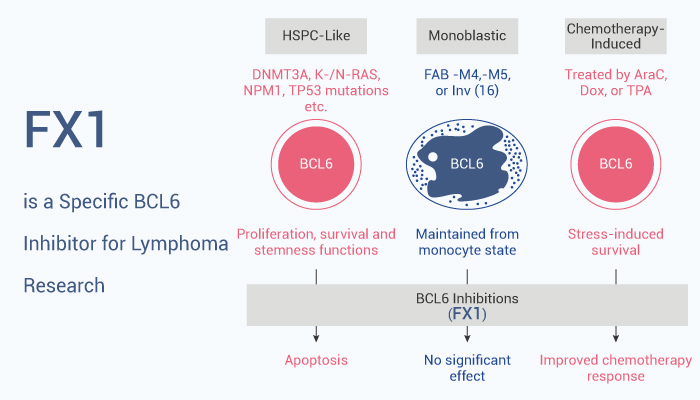Bcl-6 (B-cell lymphoma 6) is a protein that in humans is encoded by the BCL6 gene. Mutations in BCL6 can lead to B cell lymphomas because it promotes unchecked B cell growth. In addition, BCL6 is a transcriptional repressor required for B cells to form germinal centers (GCs) during the humoral immune response. BCL6 enables proliferation and survival of GC B cells by repressing various checkpoint pathways. Mechanistically speaking, BCL6 represses genes that would otherwise prevent the proliferation and survival of GC B cells by recruiting the SMRT, NCOR, and BCOR corepressors to its N-terminal BTB domain.
FX1 is a specific and high affinity BCL6 inhibitor.

FX1 binds an essential region of the BCL6 lateral groove and disrupts formation of the BCL6 repression complex. Meanwhile, FX1 fails to significantly inhibit of any other kinases. In addition, FX1 profoundly reduces recruitment of BCOR and SMRT to all 3 BCL6 (CASP8, CD69, CXCR4, CDKN1A, and DUSP5) target genes. Also, FX1 induces greater target gene reactivation in agreement with its greater disruption of BCL6 complexes. Hence, FX1 can broadly disrupt the BCL6 transcriptional program in diffuse large B cell lymphomas (DLBCL) cells. The purpose of FX1 is to kill BCL6-dependent tumors. FX1 shows a selective effect on BCL6-dependent DLBCLs with average GI50 values of about 36 μM, whereas GI50 values could not be determined in BCL6-independent DLBCLs.
FX1 (50 mg/kg; i.p. injection) shows no signs of toxicity, inflammation, or infection in SCID mice bearing SUDHL-6 xenografts. The half-life is approximately 12 hours. Besides, low doses of FX1 induced regression of established tumors in mice bearing DLBCL xenografts. Finally, FX1 enhances response to Doxorubicin in germinal center B cells (GCB-DLBCLs) as well as the more chemotherapy-resistant activated B cell DLBCLs (ABC-DLBCLs).
In summary, FX1 is a specific and high affinity BCL6 inhibitor that targets activated B cell DLBCLs (ABC-DLBCLs).
References:
[1] Mariano G Cardenas, et al. J Clin Invest. 2016 Sep 1;126(9):3351-62.